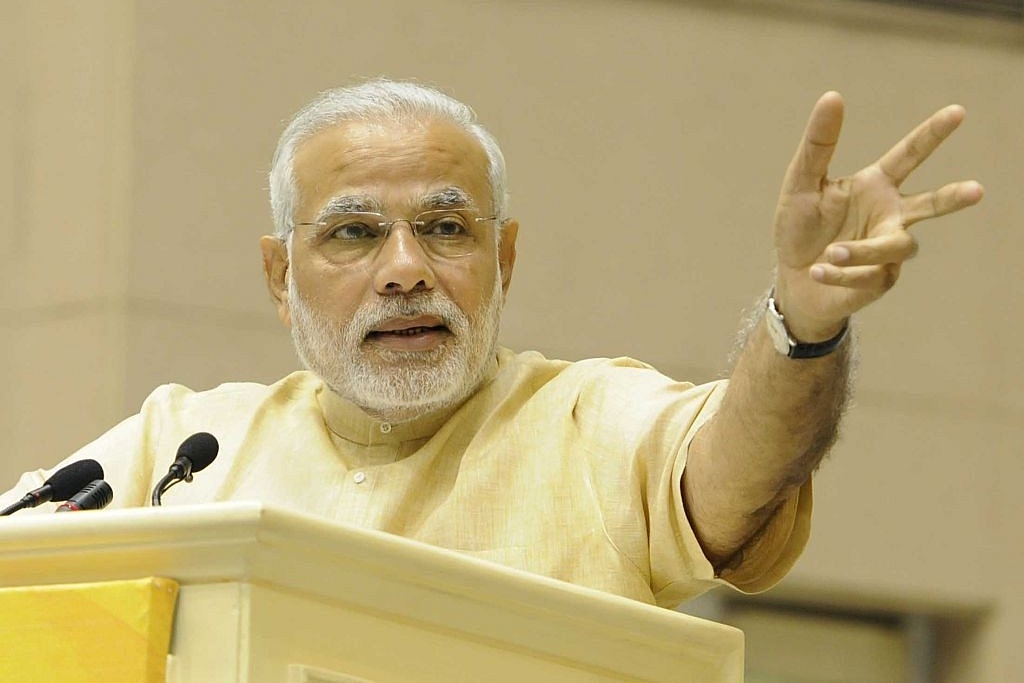Economy
Paddy MSPs: Modi’s Bow To Populism Is Nowhere As Irresponsible As UPA-1
- Modi’s MSPs will not bust the fiscal math. It is far more responsible than UPA’s 2008 gambit.

Prime Minister Narendra Modi speaking at the launch of Saansad Adarsh Gram Yojana in New Delhi. (Sushil Kumar/Hindustan Times via GettyImages)
By raising minimum support prices (MSPs) for the common variety of paddy by 13 per cent – from Rs 1,550 to Rs 1,750 per quintal – the Narendra Modi government has effectively announced that it is prepared to risk higher food inflation in a bid to woo back irate farmers.
The MSP hikes for this kharif season, which is already underway, include even higher prices for jowar (up 43 per cent), bajra (37 per cent), ragi (52 per cent), and maize (19 per cent), but these are not what will set the retail price index on fire. It is paddy that matters in kharif.
If global fuel prices also continue their uptrend (Brent crude is around $78 a barrel, edging closer to the $80 mark that worries India), overall inflation will be higher this year, especially since state assembly elections later this year and general elections in April-May next year will bring further spending by both government and political parties.
In this scenario, it is more than likely that the Reserve Bank of India will increase interest rates twice more this year, the second hike depending on the performance of the monsoon.
However, it is worth noting that even after this hike, the Modi government’s MSPs – which could cost Rs 11,000-15,000 crore in terms of food subsidies – are far more responsible than the United Progressive Alliance-1 (UPA-1) hikes of 2008, which were additionally accompanied by a farm loan waiver that cost Rs 72,000 crore.
In 2008, the UPA government boosted MSPs by 30-75 per cent, with paddy prices being raised by a hefty 32 per cent, and jowar by an amount similar to what the National Democratic Alliance (NDA) has done this year.
UPA’s poor record on inflation can be directly traced to this excess munificence in 2008, which came just before the global economy was about to crash in September 2008.
In a basic sense, NDA-2 has followed the same timetable as UPA-1 in terms of MSPs. After moderate increases in the first four years of tenure, in the year before elections MSPs were raised skywards. This is exactly what Modi’s NDA has done, but with a greater degree of moderation. In the last four years, paddy MSPs have been hiked in the range of 3-5 per cent, followed by this year’s 13 per cent.
Rajnath Singh is quoted by BloombergQuint as saying that no other government has given such a large hike for farmers, and the announced price is reportedly production cost plus 50 per cent margin. The costs computed include actual production costs plus imputed costs of family labour.
However, Singh is wrong, for the UPA-1 hikes in 2008 were clearly larger, and more inflationary.
Modi’s MSPs will not bust the fiscal math. It is a darn sight less irresponsible than UPA’s 2008 gambit.
Introducing ElectionsHQ + 50 Ground Reports Project
The 2024 elections might seem easy to guess, but there are some important questions that shouldn't be missed.
Do freebies still sway voters? Do people prioritise infrastructure when voting? How will Punjab vote?
The answers to these questions provide great insights into where we, as a country, are headed in the years to come.
Swarajya is starting a project with an aim to do 50 solid ground stories and a smart commentary service on WhatsApp, a one-of-a-kind. We'd love your support during this election season.
Click below to contribute.
Latest